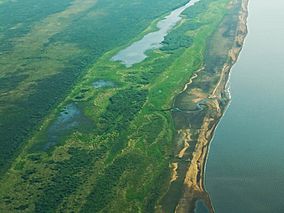Old Crow Flats facts for kids
Quick facts for kids Old Crow Flats |
|
|---|---|
|
IUCN Category IV (Habitat/Species Management Area)
|
|

Shoreline of a large lake in Old Crow Flats
|
|
| Area | 6,170 square kilometres (2,380 sq mi) |
| Designated: | 24 May 1982 |
| Reference #: | 244 |
Old Crow Flats is a huge wetland area in northern Yukon, Canada. It covers about 6,170 square kilometers (2,382 square miles) and is located along the Old Crow River. This special place is north of the Arctic Circle and almost completely surrounded by mountains.
Scientists have found very old human tools and animal bones here. These discoveries show that people lived in North America much earlier than we once thought.
Contents
About Old Crow Flats
Old Crow Flats is a very important natural area. It is protected by laws like the Yukon Wildlife Ordinance and the Migratory Birds Convention Act. This means the animals and plants living there are kept safe.
In 1982, Old Crow Flats was named a "wetland of international importance" under something called the Ramsar Convention. This is a global agreement to protect wetlands because they are so important for wildlife and the environment.
A Home for Amazing Wildlife
This wetland is a key place for many animals. It is a very important breeding area for water mammals and birds like peregrine falcons. Many waterfowl, such as ducks and geese, come here to shed their old feathers (this is called moulting) during the summer. In the autumn, many different bird species stop here to rest and feed before continuing their long journeys. Because of this, Old Crow Flats is known as an Important Bird Area.
The area has more than 2,000 ponds and marshes, which makes it a perfect home for all these creatures. Part of Old Crow Flats is now even part of Vuntut National Park, which helps protect it even more.
Discovering Ancient History
Old Crow Flats is famous for its amazing archaeology (the study of human history through digging up old things). It has some of the richest sites in North America that show where early humans lived.
More than 20,000 fossils have been found here. Some of these fossils are from animals never seen before in North America! Another important area with signs of early humans, called the Bluefish Caves, is also nearby.
Fossils and Ancient Animals
Over time, rivers like the Old Crow River and Porcupine River have changed their paths. As they moved, they cut through old layers of earth that held many fossils. This caused millions of fossils to wash out and collect along the new riverbanks.
These fossils tell us about many incredible animals that lived long ago. Imagine seeing:
- Mammoths (like giant, hairy elephants)
- Mastodons (another type of ancient elephant)
- Giant beavers (as big as a bear!)
- Ground sloths (huge, slow-moving animals)
- Several kinds of horses
- Giant bison
- Short-faced bears (a very large, fast bear)
- American lions (bigger than today's lions)
- Short-faced skunks
- And many more!
Scientists have found some mammoth bones that look like they were broken by humans using tools. These bones have been dated to be between 25,000 and 40,000 years old. This is very exciting because it suggests that humans were in North America much earlier than many people thought!

